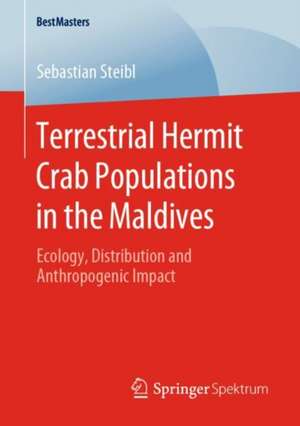Terrestrial Hermit Crab Populations in the Maldives: Ecology, Distribution and Anthropogenic Impact: BestMasters
Autor Sebastian Steiblen Limba Engleză Paperback – 21 feb 2020
About the Author:
Sebastian Steibl is a PhD student at the Institute of Animal Ecology at the University of Bayreuth, Germany. In his actual PhD research, he builds up on the presented work to investigate the architecture as well as functionality of small insular ecosystems and to analyze how different anthropogenic disturbances impact those ecosystem processes.
Din seria BestMasters
-
 Preț: 362.32 lei
Preț: 362.32 lei - 13%
 Preț: 367.41 lei
Preț: 367.41 lei -
 Preț: 364.14 lei
Preț: 364.14 lei - 5%
 Preț: 403.96 lei
Preț: 403.96 lei -
 Preț: 377.18 lei
Preț: 377.18 lei -
 Preț: 367.05 lei
Preț: 367.05 lei - 13%
 Preț: 364.57 lei
Preț: 364.57 lei - 13%
 Preț: 366.14 lei
Preț: 366.14 lei - 13%
 Preț: 368.35 lei
Preț: 368.35 lei -
 Preț: 391.41 lei
Preț: 391.41 lei - 13%
 Preț: 367.41 lei
Preț: 367.41 lei -
 Preț: 311.76 lei
Preț: 311.76 lei -
 Preț: 396.86 lei
Preț: 396.86 lei -
 Preț: 406.59 lei
Preț: 406.59 lei -
 Preț: 365.66 lei
Preț: 365.66 lei -
 Preț: 394.31 lei
Preț: 394.31 lei - 13%
 Preț: 365.83 lei
Preț: 365.83 lei - 13%
 Preț: 396.42 lei
Preț: 396.42 lei - 20%
 Preț: 366.22 lei
Preț: 366.22 lei -
 Preț: 364.14 lei
Preț: 364.14 lei -
 Preț: 367.05 lei
Preț: 367.05 lei -
 Preț: 346.23 lei
Preț: 346.23 lei -
 Preț: 365.59 lei
Preț: 365.59 lei -
 Preț: 392.13 lei
Preț: 392.13 lei -
 Preț: 251.34 lei
Preț: 251.34 lei - 20%
 Preț: 292.10 lei
Preț: 292.10 lei -
 Preț: 404.05 lei
Preț: 404.05 lei -
 Preț: 393.58 lei
Preț: 393.58 lei -
 Preț: 393.58 lei
Preț: 393.58 lei -
 Preț: 344.87 lei
Preț: 344.87 lei -
 Preț: 410.77 lei
Preț: 410.77 lei -
 Preț: 411.75 lei
Preț: 411.75 lei -
 Preț: 379.30 lei
Preț: 379.30 lei -
 Preț: 411.32 lei
Preț: 411.32 lei -
 Preț: 412.89 lei
Preț: 412.89 lei -
 Preț: 377.73 lei
Preț: 377.73 lei -
 Preț: 378.12 lei
Preț: 378.12 lei -
 Preț: 412.51 lei
Preț: 412.51 lei -
 Preț: 481.79 lei
Preț: 481.79 lei -
 Preț: 377.18 lei
Preț: 377.18 lei -
 Preț: 480.06 lei
Preț: 480.06 lei -
 Preț: 376.04 lei
Preț: 376.04 lei -
 Preț: 382.95 lei
Preț: 382.95 lei -
 Preț: 377.95 lei
Preț: 377.95 lei -
 Preț: 412.68 lei
Preț: 412.68 lei -
 Preț: 376.80 lei
Preț: 376.80 lei -
 Preț: 380.45 lei
Preț: 380.45 lei -
 Preț: 410.17 lei
Preț: 410.17 lei -
 Preț: 410.94 lei
Preț: 410.94 lei -
 Preț: 380.63 lei
Preț: 380.63 lei
Preț: 374.68 lei
Nou
Puncte Express: 562
Preț estimativ în valută:
71.70€ • 76.67$ • 59.78£
71.70€ • 76.67$ • 59.78£
Carte tipărită la comandă
Livrare economică 18 aprilie-02 mai
Preluare comenzi: 021 569.72.76
Specificații
ISBN-13: 9783658295400
ISBN-10: 3658295406
Pagini: 53
Ilustrații: XIII, 53 p. 8 illus.
Dimensiuni: 148 x 210 mm
Greutate: 0.1 kg
Ediția:1st ed. 2020
Editura: Springer Fachmedien Wiesbaden
Colecția Springer Spektrum
Seria BestMasters
Locul publicării:Wiesbaden, Germany
ISBN-10: 3658295406
Pagini: 53
Ilustrații: XIII, 53 p. 8 illus.
Dimensiuni: 148 x 210 mm
Greutate: 0.1 kg
Ediția:1st ed. 2020
Editura: Springer Fachmedien Wiesbaden
Colecția Springer Spektrum
Seria BestMasters
Locul publicării:Wiesbaden, Germany
Cuprins
Shell Resource Partitioning as a Mechanism of Coexistence in Two Co-occurring Terrestrial Hermit Crab Species.- Daytime Activity and Habitat Preferences of Two Sympatric Hermit Crab Species (Decapoda: Anomura: Coenobita).- Disentangling the Environmental Impact of Different Human Disturbances: a Case Study on Islands.
Notă biografică
Sebastian Steibl is a PhD student at the Institute of Animal Ecology at the University of Bayreuth, Germany. In his actual PhD research, he builds up on the presented work to investigate the architecture as well as functionality of small insular ecosystems and to analyze how different anthropogenic disturbances impact those ecosystem processes.
Textul de pe ultima copertă
Terrestrial hermit crabs are among the most widespread beach-dwelling organisms with key ecological functions but receive only very limited research attention. Sebastian Steibl demonstrates how physical parameters shape their overall distribution, presents a possible mechanism for their speciation and coexistence and shows for the first time how different human activities can have a major impact on their populations. The author points out that terrestrial hermit crabs, due to their conspicuous behavior to utilize shells, are a good model to study mechanisms of competition and coexistence in natural populations. Furthermore, they are suitable indicator organisms to assess human impact, as they respond differently depending on the type of anthropogenic disturbance.
Contents
- Shell Resource Partitioning as a Mechanism of Coexistence in Two Co-occurring Terrestrial Hermit Crab Species
- Daytime Activity and Habitat Preferences of Two Sympatric Hermit Crab Species (Decapoda: Anomura: Coenobita)
- Disentangling the Environmental Impact of Different Human Disturbances: a Case Study on Islands
Target Groups
Scientists and students in the field of ecology, zoology and conservation biology
About the Author
Sebastian Steibl is a PhD student at the Institute of Animal Ecology at the University of Bayreuth, Germany. In his actual PhD research, he builds up on the presented work to investigate the architecture as well as functionality of small insular ecosystems and to analyze how different anthropogenic disturbances impact those ecosystem processes.
Caracteristici
New insights in decapod biology and conservation
